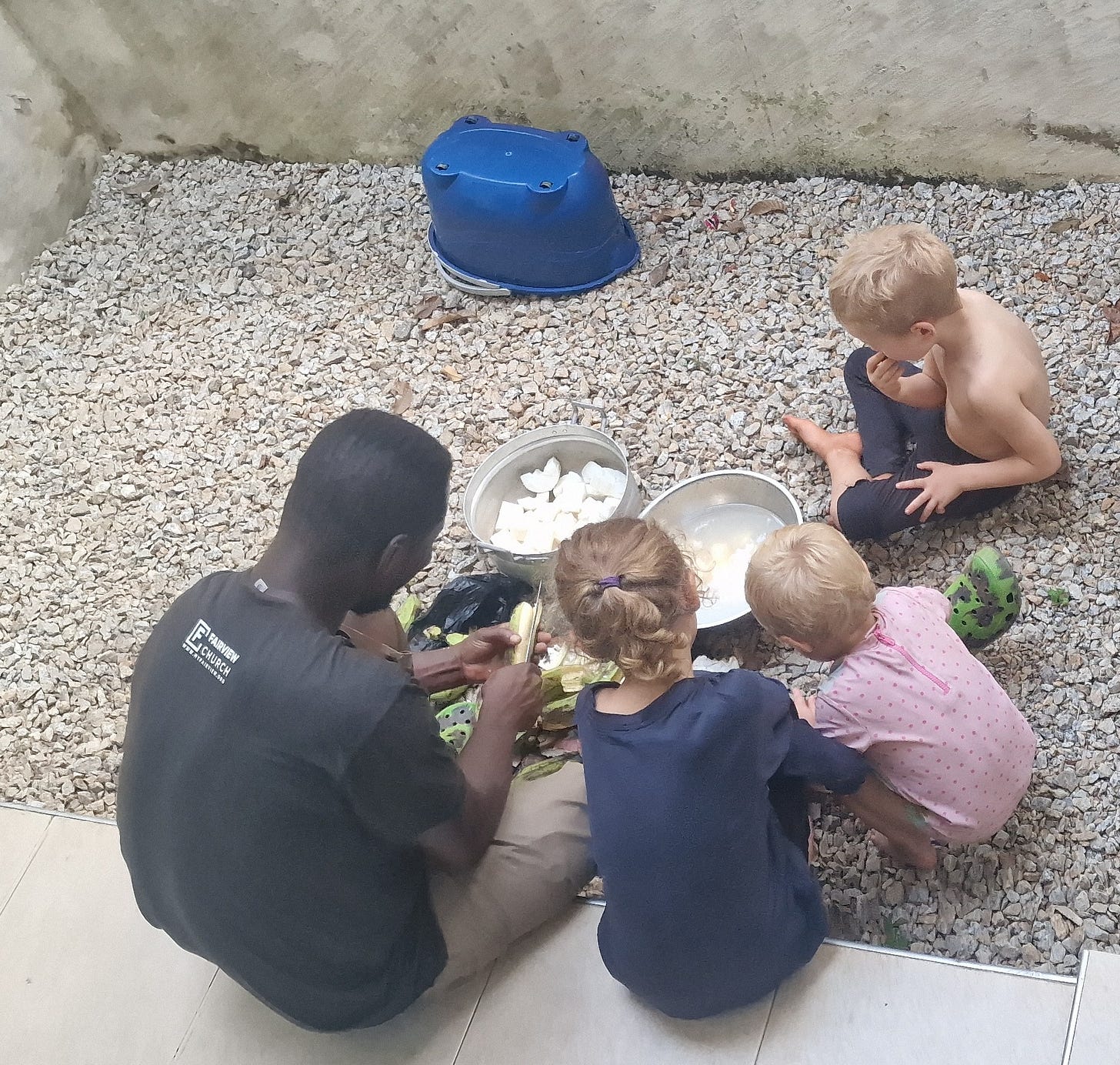Ozempic is needed because of how we raise children
How to raise a child who'll never need GLP-1 drugs
A note before we start: You might be thinking that this article’s going to be about obesity.
It is not.
The air is saturated with harmattan dust. It’s turning the sky to milk and the sun into a coin in the sky, but not doing anything to turn down the heat. A lone cricket scratches out a song as a pair of butterflies haul themselves past, swimming through the sticky air. The birds are tired. The plants are drooping. The already-fermented banku porridge in front of me sours a little further in its plastic bag. A bubble arises from its depths. I push it away, defeated, and restart the conversation with the man who was visiting the same forest clearing in the Ghanaian rainforest.
“So, what surprised you about working in London?”
Thomas is a medic, who’s spending some time in the forest between shifts to get out of the scalding air blowing down from the Sahara. We have a lot in common. Including the fact that he did some of his training in the UK. It’s been interesting listening to his perspective on medicine in the West over the past hour.
This time, for the first time, there’s a long pause.
“Alcoholism.” His English, though accented, is perfect. “Almost all I saw was cancer and alcohol addiction. You British people drink far too much. I have never seen anything like it.”
Addiction is rife in WEIRD cultures
The UK’s alcohol problem is only one facet of WEIRD (Western, Educated, Industrialised, Rich, and Democratic) cultures’ overall addiction problem. While people all over the world fall prey to addiction, the numbers in the industrialised world are among the worst. The UK has one of the highest rates of drug-abuse deaths in Europe. The US has its own widely-publicised opioid epidemic (25 million people abusing, with annual costs to the country of over $90bn), and one in five citizens of the EU are unable to stop smoking.
But why, given the huge amount of health education that comes along with our upbringing in these countries, are we so dependent on clearly harmful vices?
Our bodies have evolved to calibrate our reward systems
Let's start the answer with a quick refresher on addiction, for those of us who are mercifully ignorant of this particular neurological demon.
While people can still have fun debates about whether free will exists at a quantum-physical level, the answer at a biological level is pretty clear. Our genes build our bodies, and then install a smart little consciousness to act as the pilot during times of uncertainty. They give those pilots (i.e. us) quite a lot of autonomy, but there are certain specific things that they need to guarantee we achieve. Eating, for example. Or mating.
To achieve this, they build us with a reward system and pre-program it to make certain behaviours feel really good. Eating, for example. Or mating.
(NB. I'm going to savagely over-simplify this bit for ease of description. As with all biology, it's really a huge tangled mess. Interesting to read about, but, yeah: huge tangled mess).
That reward system has two components. First up, providing a feeling of contentment and stillness when we're achieving what our bodies need in the long-term (like social connections, enough movement, enough sleep, the right diet), is the serotonin system. This ‘happiness’ system signals “Everything's great! 👍 Chill out, take time to have fun, and keep doing what you're doing!”.
The second part, providing a feeling of ecstasy and exhilaration when we've done something our body needed in the short term (like overcome a danger, acquired some scarce resource, eaten highly nutritious food, or, yes, mated), is the dopamine system. This ‘pleasure’ system signals “Awesome! 🎉 Do that again! Work hard right now, because this opportunity won't be around forever!”.
Clearly, being too ‘chilled out’ would get in the way of the ‘get up and go’ needed when important things are in short supply, so activation of the dopamine system has the ability to inhibit the serotonin system.
And, obviously, you only want the pilot aiming the body at the most important opportunities and not wasting their energy chasing after every mildly-rewarding thing like a magpie in a glitter factory. So, the dopamine system has a tuning function. High levels of dopamine activation make the receptors less sensitive, meaning that only the highest-dopamine-activating events get the attention.
So far, so well-adapted, right? Right. Within natural, normal levels of dopamine.
Unnaturally rewarding exposures alter that calibration process
However, if you create a substance or activity that releases an unnaturally large amount of dopamine, it does three things:
It is incredibly rewarding, creating a burst of energy and a desire to repeat.
It starts to dampen the serotonin system, reducing relaxed happiness.
It starts to reduce the sensitivity of the dopamine system, reducing the amount of reward that can now be found in previously rewarding things like eating (or mating). This change can become permanent.
And, if that unnaturally dopamine-releasing thing is also unnaturally available for more than a short period of time, then these three processes often end up producing a pilot who is unhappy, anxious, and unable to find pleasure in anything other than a few specific, hyper-dopaminergic things.
An addict.
There are various things that make you more or less susceptible to becoming addicted. Genetics play a part. As do certain strongly held convictions. But there’s a lot more to it than that, and, you guessed it, much of it starts in childhood:
(NB. You'll have noticed that I've not used the word ‘drug’ here. That's because the whole point of my articles is to highlight the links between childhood experiences and adulthood health. And, when it comes to childhood creating addictable adults, drugs are a red herring. This is not about avoiding kids getting hold of Class As).
WEIRD culture exposes kids to addictive stimuli from an early age
This all brings us back to our original question: Why do so many people in the West have reward systems that aren’t functioning properly?
In the WEIRDest corners of our world, there are now plenty of things that release unnatural amounts of dopamine. Very sweet food or drinks, other ultra-processed food, and a lot of ‘for-kids’ digital media are all specifically designed to generate as much dopamine in children's brains as possible.

Why? Generously, because providing pleasure to wee kiddies is a nice thing to do. Less generously, because addicts (even small ones) are really good for business.
Whatever the motivation, children exposed to these things will slowly lose the ability to find pleasure in non-dopamine-engineered things like normal food or outdoor play activities. In many cases, they also start to exhibit other signs of addiction including general low mood and anxiety.
It doesn't take long before kids will scream and cry and refuse to eat breakfast cereals that aren't aggressively sweet, or will sullenly watch their toes on a beautiful walk with their beautiful family as they count down the seconds between them and their iPad. These kids aren't being unreasonable or childish or ‘bad’, their reward systems are just offering them literally no biochemical reason to do anything else.
(NB. Even receiving collections of physical toys can create the dopamine spikes needed to increase addictability and ruin their ability to enjoy normal play).
Anyway, here's the key point: that new level of dopamine sensitivity eventually becomes permanent and, once it does, that person is locked into finding normal life a bit dull, and grey, and unrewarding. They are then much more likely to become addicted to other things throughout life. Cigarettes, shopping, alcohol, porn, you name it.
Clearly, not every child that plays Fortnite is going to end up gambling their pension away at 70, but the numbers are not good. Brace yourselves.
Around 15% of WEIRD children are addicted to ultra-processed food. Problematic smartphone use, bearing many of the classical markers of addiction, is seen in 20% of children and young people.
That's not great, but it's going to get worse as these kids grow up. More than 90% of adults addicted to drinking, smoking, or illegal drugs began before they were 18.
WEIRD countries now provide, without a doubt, the highest availability of addictive substances to children since we took away their tobacco in 1908.
Ozempic reduces our reward response
You might be thinking ‘Hang on, Guen, I started reading this because you said the word Ozempic.’ Where’s the obesity piece? Where’s the food?
Ozempic, and its other GLP-1 receptor agonists, are taking the industrialised world by storm. Touted as ‘wonder drugs’, they seem to affect every. single. ‘Western’. disease.
As they are used for obesity, you might think they had something to do with the gut, and you’d be right. They slow stomach emptying and alter how the gut moves. But if you look at the science, their major action is not through tweaking a chemical in a metabolic pathway. They change what people want to eat. The biggest breakthrough in obesity medicine has come from a drug-induced dietary change.
Think about that for a moment. The benefits of the GLP-1 drugs is they make people want to eat more healthily. How?
Ozempic and drugs like it reduce the release of dopamine in response to pleasurable stimuli. They appear to have greatest effect against fast-release events, and less against lower releases. They blunt the pleasure to be found in certain high-dopamine things. The fact that the most visible effect of this is that many people lose weight says more about the degree to which our food environment has been dopamine-engineered than it does about GLP-1 drugs themselves.
The effects aren’t just limited to reducing the diseases of overconsumption either! These drugs reduce impulsive and compulsive behaviours - smoking, alcohol consumption, gambling, and shopping. They alter how people experience reward, how they feel motivation, and how they make decisions.
There’s a reason that so many adults will be prescribed these drugs. Because they are living within their broken reward systems, and those manifest in obesity, cravings, food noise, and the other compulsions we bracket under the term ‘addiction.’
Well this is great! We can use GLP-1 drugs to fix a whole section of WEIRD humanity’s problems in one fell swoop!
Not so fast. There’s a catch. (NB. It’s medicine, there’s always a catch).
By dialling down our dopamine signalling, Ozempic dials down everything we find rewarding. Dopamine-blocking drugs have been designed and tested for fighting addiction in the past. Do you know why they failed? Because they increase the rate of suicide. Life without reward feels flat and hopeless.
Now, clearly, Ozempic and GLP-1 drugs like it are not total dopamine blockers, but they produce a shadow of this same effect: the removal of motivation for some parts of life. For many people, it’s entirely worth it for the benefits they get. But people taking these drugs may lose that nuance and, for some, living life in monochrome is a big price to pay, so they stop taking them.
Paying huge amounts of money for GLP-1 drugs is, for many people, better than surviving with a damaged dopamine system. However, these folks would be having a much better (and less expensive) time if they’d had the good fortune to avoid that damage in the first place. Which is something we can help kids achieve, if we want to,
This is how we raise children who are less addictable
Look. A huge amount of staying healthy into adulthood relies on making good choices. Choosing to eat healthily, move lots, connect with people, and, you know, not deliberately inhale toxic smoke and fumes. It is nearly impossible for an addicted brain to achieve this. Free will doesn't exist if there's no reward in it.
Luckily, there are some very powerful tools for boosting adulthood health by preventing addiction from getting a foothold.
There are two things we need to remember:
Age of exposure - the earlier a child is exposed to addictive stimuli, the more likely they are to become addicted
Addiction transfer - A child who is addicted to one thing is more likely to become addicted to others
So, we need to delay exposure to any addictive (hyperdopaminergic) stimuli for as long as we possibly can. Every day, every week, every month makes a difference.
Let’s take those addictive stimuli one by one:
Sugar - the refined addictive substances we give to babies almost as soon as they can eat. What does it take to raise children who don’t want sugar? I’ve linked to my Candy Crushed article below.
Ultra-processed food - the engineered combinations of ingredients that unnaturally light up our brains. Also, for most of us, our biggest source of sugar. Avoid as much as possible. Not just for their addictive potential, but also because their hyperpalatable design makes minimally processed foods less appealing. Hey presto - picky eating.
Digital media and screen time - We love stories and we want to save energy. Of course we want to watch videos on a smartphone, play games on a tablet, or sit in front of the television. But these forms of media have been designed to stimulate dopamine release - that’s what locks kids to the device. It’s good business sense, but we can’t afford what they do to our kids’ sense of reward.
Toys - the stuff we give kids because their enjoyment triggers our own dopamine response. But we’re WEIRD in the world - toys are just not really a thing in other cultures. But when a child has access to unlimited toys, they can engage with each one for a minute, move on, and get a dopamine hit from the novelty of the next. Heavily prune the toy collection. Help kids to put effort into their play.
You might be thinking, “I’ve made the mistakes. There’s nothing I can do.”
But you’d be wrong. Yes, there are times when it’s much easier to make small tweaks that kids don’t notice, that put them on the path to better adult health. Those times are usually in early childhood.
Although the changes have to be bigger in older children to have the same effect, they can still be done. And kids aren’t stupid. Older kids can be involved in the discussion and can be a part of the solution. Although reward systems are mostly set up during childhood, habits can be altered at any time, and then the reward system drifts in a better direction.
Ozempic will undoubtedly help millions with their health. But it’s not without its downsides.
It doesn’t need to be part of your child’s future.
Want to hear my partner and I discuss our thoughts on what drives addictability in children? We have a podcast where we use the topic from the previous post and give context and examples to help bring it to life. There’s also a weekly news section where we dive into interesting research into child development from the previous week.
This is the sound of Sunday evenings in our house!
You might also like:
What does it take to raise children who don’t want sugar?
Why aren’t all children picky eaters?
How do we get children to put more effort into their play?
And a few other good articles I’ve read on the topic
From
, on how the dopamine industrial complex affects children:
From
, on her own very personal experience of dopamine and parenting:
And finally, a Substack from
that explores the political and corporate strategies which make addiction an acceptable mainstream business model.
Notes
Drug use in the UK: https://www.statista.com/topics/7547/drug-use-in-the-united-kingdom-uk/#topicOverview
The opioid epidemic in the US: Wilkerson, Richard Gentry, et al. "The opioid epidemic in the United States." Emergency Medicine Clinics 34.2 (2016): e1-e23.
Increased dopamine responses in childhood are linked to later addiction development: https://www.cell.com/trends/pharmacological-sciences/abstract/S0165-6147(14)00052-2?cc=y%3Fcc%3Dy
Kounang, N. (2019, March 19). What makes food addictive? The science behind why we can't stop eating certain foods. CNN. https://www.cnn.com/2019/03/19/health/bliss-point-addictive-food/index.html
Kiseleva, N., and S. Kiselev. "Relationship between computer game addiction and low mood in children." European Psychiatry 64.S1 (2021): S568-S568.
Kuss, Daria J., and Mark D. Griffiths. "Online gaming addiction in children and adolescents: A review of empirical research." Journal of behavioral addictions 1.1 (2012): 3-22.
Food addiction in children: https://onlinelibrary.wiley.com/doi/full/10.1111/obr.13183
Soda addiction in children: https://www.ncbi.nlm.nih.gov/pmc/articles/PMC7689136/
How the brain is shaped in addiction: https://pmc.ncbi.nlm.nih.gov/articles/PMC3181920/
How toys affect a child’s attention: https://www.sciencedirect.com/science/article/pii/S0163638321000643










The conspiracy to never mention porn amongst female academics continues.
This was very interesting and educational, especially to this behaviorist who, in conceptualizing addiction, gives more causal status to outside-the-skin environmental contingencies (which undoubtedly affect internal events, we just don’t often discuss how). Always interesting to read the perspective of those who look more toward brain workings before the external environment, as we end up saying the same things, just with emphasis on different causes. I liked the sentence, “Free will doesn't exist if there's no reward in it.” Clever and true! I also liked your points about the effects of the GLP 1 drugs’ efficacy pointing to broken environmental contingencies as the ultimate cause, rather than something structural about the organism. Thanks for the great read!